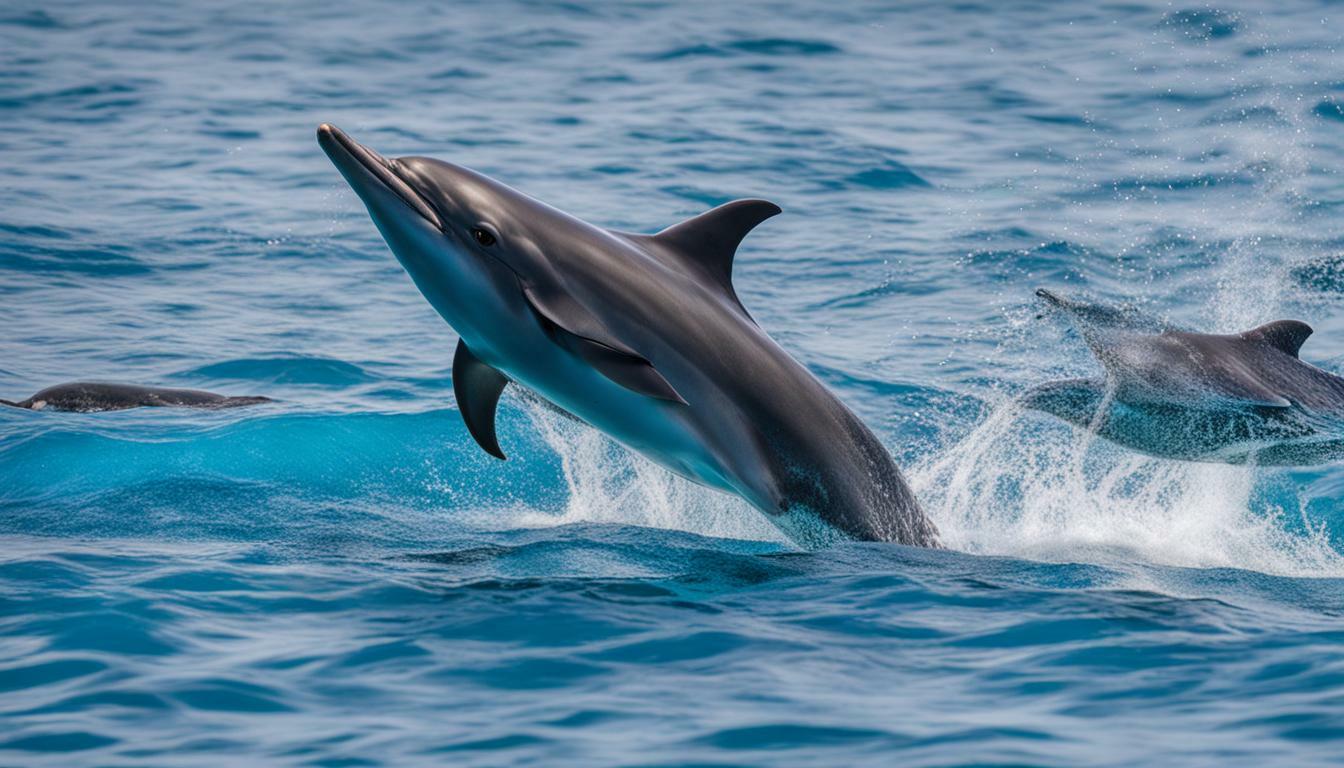Dolphins are known for their remarkable communication skills and complex language system, which have captivated scientists and researchers for decades. These highly intelligent creatures utilize a form of communication known as “Dolphinese,” comprising a sophisticated range of clicks, whistles, and melodic hums to convey intricate thoughts and ideas. Scientists have made groundbreaking progress in decoding this intricate language, allowing us to gain further insight into the hidden world of dolphins.
One fascinating discovery is that dolphins have specific terms and expressions to refer to humans. Interestingly, the majority of these terms lean towards the negative spectrum, providing a unique glimpse into how dolphins perceive us. This revelation sparks the potential for deeper collaboration and understanding between humans and dolphins, offering a rare opportunity to bridge the gap between our species.
Decoding Dolphinese not only holds promise in unraveling the mysteries of dolphin communication but also sheds light on other aspects of their lives. By understanding their language, we may gain valuable insights into their navigation abilities, hunting strategies, and emotional connections. Yet, this task is not without its challenges.
Elusiveness is a significant hurdle in deciphering Dolphinese, as dolphins are agile and swift creatures, making it difficult to study them up close. Additionally, their language heavily relies on context, making it essential to observe dolphins in their natural environment to fully comprehend their communication. Nonetheless, scientists and researchers remain steadfast in their pursuit, making encouraging progress towards a deeper level of communication with dolphins.
In the following sections, we will explore the various methods dolphins employ in communication, the complexities of their language, breakthroughs in deciphering Dolphinese, surprising discoveries regarding their terms for humans, and the potential for collaboration between humans and dolphins. Through these discoveries and ongoing research, we continue our journey of unlocking the secrets behind dolphin communication and language.
How Do Dolphins Communicate?
Dolphins communicate through a variety of vocalizations, using clicks, whistles, and body movements to convey messages and express emotions. Their communication system, known as Dolphinese, has fascinated scientists for years. These intelligent creatures possess the ability to convey complex thoughts and ideas through their unique language.
Dolphins use clicks, which are short, high-frequency sounds, to navigate their surroundings and locate prey. These clicks are produced by forcing air through their nasal passages, creating a series of rapid bursts of sound. Scientists believe that dolphins use clicks to create a form of echolocation, allowing them to “see” their environment through sound.
In addition to clicks, dolphins also produce a wide range of whistles. These whistles are thought to serve as a means of communication between individuals or pods. Each dolphin has its own signature whistle, similar to a unique “name,” which allows them to identify and recognize one another within their social groups.
Furthermore, dolphins communicate through body movements, using a combination of flips, spins, and tail slaps to convey their intentions and emotions. These visual displays can signify aggression, playfulness, or even courtship rituals. By observing the body language of dolphins, researchers can gain insights into their social dynamics and behavior.
| Vocalization | Description |
|---|---|
| Clicks | Short, high-frequency sounds used for echolocation |
| Whistles | Distinctive sounds serving as “names” for individual dolphins |
| Body Movements | Flips, spins, and tail slaps used to convey intentions and emotions |
Understanding dolphin communication is not only fascinating, but it also holds great potential for human-dolphin collaboration. By deciphering their language, researchers hope to establish a deeper connection with dolphins, allowing for greater cooperation and mutual understanding. The ongoing progress in decoding Dolphinese paves the way for insights into various aspects of dolphin life, such as their navigation abilities, hunting strategies, and emotional connections.
However, decoding Dolphinese presents its challenges. Dolphins are elusive creatures, and their communication is highly context-dependent. It requires careful observation and analysis to unravel the intricacies of their language. Despite these difficulties, scientists persist in their efforts and remain hopeful that one day, humans and dolphins will be able to communicate on a profound level.
The Intricacies of Dolphin Language
The language of dolphins is a fascinating subject, as it reflects their intelligence, social dynamics, and unique way of perceiving the world around them. Dolphins communicate through a complex system of vocalizations, clicks, whistles, and melodic hums, collectively known as Dolphinese. These sounds are not only used for basic communication but also convey intricate thoughts and ideas, showcasing the cognitive abilities of these remarkable creatures.
Researchers have discovered that dolphin language goes beyond simple communication. Dolphins possess an array of specific terms and expressions to refer to humans, providing insight into their perception of our species. Interestingly, the majority of these terms tend to have negative connotations, hinting at the complex relationship between dolphins and humans.
The deciphering of Dolphinese has opened up new possibilities for collaboration and understanding between humans and dolphins.
Decoding Dolphinese is a challenging task. Dolphins are elusive creatures, making it difficult for researchers to study them in their natural habitat and observe their language in context. Furthermore, dolphin language is highly context-dependent, meaning that the meaning of their vocalizations can vary depending on the situation and the individuals involved. Despite these challenges, scientists are making groundbreaking progress in deciphering Dolphinese and hope to eventually communicate with dolphins on a deeper level.
| Benefits of Decoding Dolphinese | Challenges in Decoding Dolphinese |
|---|---|
| 1. Collaboration and understanding between humans and dolphins | 1. Dolphins’ elusiveness in their natural habitat |
| 2. Insights into dolphin navigation and hunting strategies | 2. Context-dependent nature of dolphin language |
| 3. Understanding emotional connections among dolphins | 3. Limited availability of data for analysis |
Deciphering Dolphinese not only has the potential to deepen our understanding of dolphin communication but also uncover other aspects of their lives, including navigation, hunting strategies, and emotional connections within their social groups. As scientists continue their research, the study of dolphin language promises to unveil new insights into the rich and complex world of these magnificent marine creatures.
Decoding Dolphinese: A Breakthrough in Communication
Researchers have made significant strides in unlocking the secrets of Dolphinese, the intricate language used by dolphins, thanks to advancements in understanding their echolocation abilities and cognitive processes. Dolphins communicate through a sophisticated system of vocalizations, utilizing clicks, whistles, and melodic hums to convey complex thoughts and ideas. Through the study of these vocalizations, scientists have been able to decipher the language of dolphins and gain insight into their intelligence and social behavior.
One of the key factors in decoding Dolphinese is the understanding of echolocation. Dolphins use echolocation to navigate and locate prey in their aquatic environment. This ability allows them to emit high-frequency clicks and interpret the echoes that bounce back, providing them with detailed information about their surroundings. By studying these echolocation signals, researchers have been able to identify specific patterns and meanings within the dolphins’ communication system.
Another crucial aspect of decoding Dolphinese is understanding the cognitive processes of dolphins. These intelligent creatures have been found to possess a complex set of social behaviors, including cooperation, coordination, and vocal mimicry. By observing their interactions and studying their brain activity, scientists have gained valuable insights into the cognitive abilities of dolphins and how they process and interpret information.
The Promising Future of Dolphin Communication
The deciphering of Dolphinese has opened up new possibilities for collaboration and understanding between humans and dolphins. Researchers believe that by acquiring a deeper understanding of dolphin communication, we can establish a stronger connection with these remarkable creatures and learn more about their world. The knowledge gained from decoding Dolphinese has the potential to shed light on other aspects of dolphin life, such as their navigation techniques, hunting strategies, and emotional connections.
However, decoding Dolphinese is not without its challenges. Dolphins are highly elusive creatures, making it difficult to establish consistent and meaningful communication. Furthermore, their language is context-dependent, meaning that the meaning of their vocalizations can change based on the situation or the presence of other dolphins. These complexities make the task of decoding Dolphinese a complex and ongoing endeavor.
Nevertheless, researchers remain optimistic and continue to make progress in understanding and communicating with dolphins. As technology and techniques improve, scientists hope to bridge the gap between human and dolphin communication, unlocking a deeper level of understanding and paving the way for future collaborations between our two species.
Dolphins’ Terms for Humans: A Surprising Discovery
Scientists have discovered that dolphins possess a repertoire of terms and expressions to refer to humans, with a notable inclination towards negative associations. This finding not only reveals the complexity of dolphin language but also sheds light on their perception of our species. Dolphins, known for their intelligence and social behavior, have developed a distinct set of vocalizations and gestures to signify humans and communicate their thoughts and emotions.
In their interactions with humans, dolphins have been observed using specific terms to convey a range of feelings, including caution, curiosity, and even aggression. These terms are believed to be part of their intricate communication system, referred to as Dolphinese. Researchers have documented instances where dolphins emit distinct vocalizations coupled with certain body postures to express their perception of humans. This discovery challenges the conventional notion that dolphins perceive humans as benign or neutral entities.
The negative connotations associated with dolphins’ terms for humans have sparked intriguing debates among experts. Some believe that it stems from dolphins’ encounters with humans in captivity or through negative interactions in the wild. Others speculate that it could be a result of dolphins’ inherent wariness towards unfamiliar beings. The exact reasons behind this negative bias are yet to be fully comprehended, but it is a fascinating aspect that warrants further investigation.
| Dolphin Term | Meaning |
|---|---|
| Squawkback | Warning or cautionary signal when humans approach |
| Skinnypants | Derogatory term for humans, possibly indicating a negative view |
| Finscuffer | A term used to express annoyance or frustration towards humans |
Decoding Dolphinese and understanding the intricacies of dolphin language is not without challenges. The elusiveness of dolphins and the context-dependent nature of their communication make it difficult to accurately interpret the meaning behind their vocalizations and gestures. Furthermore, the complex cognitive abilities of dolphins add layers of complexity to their language. However, despite these obstacles, researchers are making significant progress in deciphering Dolphinese. The ongoing advancements in technology and research methodologies provide hope for deeper communication and collaboration between humans and dolphins in the future.
Dolphins and Human Collaboration: The Potential for Understanding
The ability to communicate with dolphins on a deeper level not only opens up new opportunities for collaboration but also holds promise in enhancing our understanding of their navigation, hunting strategies, and emotional connections. Dolphins possess a complex system of communication, known as “Dolphinese,” which involves a combination of clicks, whistles, and melodic hums. Scientists have made groundbreaking progress in deciphering this intricate language, shedding light on the intelligence and social behavior of these remarkable creatures.
Decoding Dolphinese has revealed that dolphins have specific terms and expressions to refer to humans. Surprisingly, the majority of these terms carry negative connotations. This discovery has sparked further interest in understanding the perception of humans from a dolphin’s perspective and the underlying reasons behind these negative associations.
The deciphering of Dolphinese not only provides insights into dolphin cognition but also holds potential for collaboration between humans and dolphins. By understanding their language, we can foster a deeper connection with these marine mammals and work together on various projects. It also opens up opportunities for research and exploration in areas such as dolphin navigation, hunting strategies, and emotional connections within their social groups.
| Dolphin Communication | Importance |
|---|---|
| Complex language involving clicks, whistles, and hums | Reveals intelligence and social behavior |
| Specific terms and expressions referring to humans | Provides insights into dolphin perception |
| Potential for collaboration and deeper understanding | Enhances research on navigation, hunting, and social connections |
While decoding Dolphinese poses challenges due to the elusiveness of dolphins and the context-dependent nature of their language, scientists are making significant progress in bridging the gap between humans and dolphins. Continued research and technological advancements may one day allow us to communicate fluently with these fascinating creatures, unlocking a world of knowledge and collaboration.
The Challenges of Decoding Dolphinese
Decoding Dolphinese presents numerous challenges due to the elusive nature of dolphins and the context-dependent nature of their communication, making it a complex task for researchers. Scientists have made groundbreaking progress in deciphering dolphin communication, referred to as “Dolphinese.” Through their clicks, whistles, and melodic hums, dolphins convey complex thoughts and ideas. However, understanding the intricacies of their language requires overcoming several obstacles.
One significant challenge is the elusive nature of dolphins. Their behavior and communication patterns can vary depending on factors such as location, social dynamics, and individual personality. This context-dependent nature makes it difficult to create a standardized framework for decoding Dolphinese. Researchers must account for these variables to ensure accurate interpretation of dolphin communication.
Additionally, the underwater environment poses challenges for data collection and analysis. Dolphins rely on echolocation, a biological sonar system, to navigate and communicate. This means that their vocalizations and sounds are often complex and layered. Scientists face difficulties in capturing and discerning these sounds accurately, as the underwater environment can distort and amplify them. Precise equipment and extensive data analysis are required to overcome these obstacles.
Despite these challenges, researchers remain committed to understanding dolphin communication on a deeper level. The potential rewards are significant, as decoding Dolphinese could reveal insights into their navigation abilities, hunting strategies, and emotional connections. Moreover, it opens up possibilities for collaboration and mutual understanding between humans and dolphins. By overcoming the complexities of dolphin language, scientists hope to establish a bridge of communication that transcends species boundaries.
Conclusion
In conclusion, the study of dolphin communication and language has greatly expanded our knowledge of these intelligent creatures, offering a glimpse into their intricate social dynamics and cognitive capabilities.
Scientists have made groundbreaking progress in decoding the intricate communication of dolphins, referred to as “Dolphinese.” This form of communication involves clicks, whistles, and melodic hums that dolphins use to convey complex thoughts and ideas. Researchers have also discovered that dolphins possess an array of terms and expressions to refer to humans, with a preponderance of terms leaning towards the negative spectrum.
The deciphering of Dolphinese has opened up new possibilities for collaboration and understanding between humans and dolphins. It also holds promise in shedding light on other aspects of dolphin life, such as navigation, hunting strategies, and emotional connections. However, decoding Dolphinese is a complex task due to the elusiveness of dolphins and the context-dependent nature of their language. Nevertheless, researchers are making progress and hope to eventually communicate with dolphins on a deeper level.
The ongoing research into dolphin communication and language has not only highlighted the intelligence and intricacies of these marine creatures, but also the potential for a deeper connection and collaboration between humans and dolphins. By unlocking the secrets of dolphin communication, scientists have gained valuable insights into their social behavior, intelligence, and echolocation abilities. This knowledge can further our understanding of the natural world and inspire new approaches to conservation and coexistence with these remarkable creatures.







